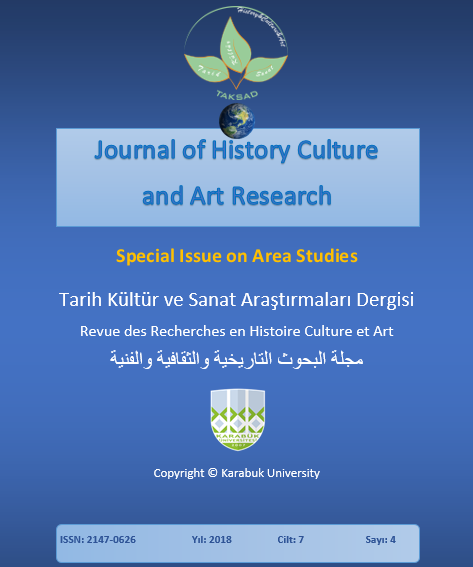The National Coloring as a Part of the Connotative Meaning of Realia
DOI:
https://doi.org/10.7596/taksad.v7i4.1820Keywords:
Reality, Color, Artistic translation, Translation transformations, National-cultural background.Abstract
The article deals with the definition of the concept of coloring, as well as the significance of its role in cultural-oriented units - the realities and ways of their translation. The study was conducted on the basis of the small genres of Kazakh fiction at the end of the 20th and beginning of the 21st centuries, short stories by Dukenbai Doszhan "Kelinshek Asuy", "Shortanbai", "Kukpar" and their translations into Russian, performed by the native speakers of the translation language "The Pass of a Young Woman" translated by I. Ukhanov, "Shortanbay" and "Kokpar" translated by Z. Nikolaeva. The main research methods were the analytical method and comparative analysis of translations with original prose from Kazakh into Russian. As a result of the research, various definitions of the concept of color were analyzed with the purpose of identifying elements characteristic of the term “realia” (“reality”), and a special role of color in revealing connotative features of realities and, accordingly, methods of transforming such units in the process of artistic translation. The main results of the research presented in the article provide an opportunity to find out how the typical tasks of the artistic translation of the Kazakh realities are implemented to recreate the specific national and cultural background of the Kazakh language picture of the world.
References
A great academic dictionary of the Russian language in 20 vols. (2004). Moscow: The Russian Academy of Sciences. Institute of Linguistic Research. Science.
Alyokhina, T.; Mardieva, L. & Shchuklina, T. (2016). The ethnic stereotype of Tatars in Russian linguistic culture. Journal of Organizational Culture, Communications and Conflict, 20, Special Issue, 228-233.
Belokurov, S. P. (eds.) (2007). Dictionary of literary terms. St. Petersburg: Parity.
Doszhan, D. (1971). Wormwood and flowers. Kokpar. In Novels and stories, (217-228). Authorized translation from Kazakh by Z. Nikolaeva. Moscow: Soviet writer.
Doszhan, D. (1971). Wormwood and flowers. Shortanbai. In Novels and stories, (245-255). Authorized translation from Kazakh by Z. Nikolaeva. Moscow: Soviet writer.
Doszhan, D. (1982). Wind Lion's Mane. Pass of a young woman. In Stories, (pp.297-314). Translation from Kazakh by I. Ukhanov. Moscow: Young guard.
Doszhan, D. (2002). Kelinshek Asuy. In Stories, (pp.228-244). Almaty: Atamura.
Doszhan, D. (2008). Farabi. In Selected works: 1-2 vol., vol. 2. Almaty: Region.
Fakhrieva, L. K.; Kirillova, Z. N. & Alkaya, E. (2017). Metaphors in Russian Poetry Translations into Tatar. Journal of History Culture and Art Research, 6(6), 153-158. DOI: http://dx.doi.org/10.7596/taksad.v6i6.1335.
Fakhrieva, L.; Kirillova, Z. & Sahin, L. (2017). Expressive Means in Tatar Translation of Alexander Sergeevich Pushkin’s Novel "Eugene Onegin". Journal of History Culture and Art Research, 6(5), 61-67. DOI: http://dx.doi.org/10.7596/taksad.v6i5.1307.
Khusnullina, G. N.; Bolgarova, R. M.; Islamova, E. A. & Zholshayeva, M. S. (2017). Comparisons of dishware names in Tatar and Russian languages. AD ALTA: Journal of Interdisciplinary Research, 7(2), 112-115.
Komlev, N. G. (1969). Components of the content structure of the word. Moscow: Izd-vo Moscow University.
Labov, U. (1975). Research of a language in its context. New in linguistics. Social linguistics, 7, 96-181. Moscow: Progress.
Lado, R. (1989). Linguistics over the borders of cultures. Translation from English by V.A. Vinogradov. New in foreign linguistics, 25, 32-62. Moscow: Progress.
Neubert, A. (1978). Pragmatic aspects of translation. In V. N. Komissarov (eds.), Issues of translation theory in foreign linguistics: Collection of art, (pp.185-201). Moscow: International Relations.
Neubert, A. & Shreve, M. (1992). Translation as Text. Kent: Kent State University Press.
Nida, E. A. (1975). Language Structure and Translation: Essays. Redwood: Stanford University Press, 1975.
Ozhegov, S. I. & Shvedova, N. Yu. (1992). Explanatory dictionary of the Russian language. Moscow: Az.
Tasibekov, K. G. (2015). Situational Kazakh. World of Kazakhs. Almaty: I.E. Takeeva A.B.
Vlakhov, S. I. & Florin, S. P. (1980). Neperevodimoe v perevode [The untranslatable in trans-lation]. Moscow: Mezhdunarodnye otnosheniia publishing.
Downloads
Published
How to Cite
Issue
Section
License
All papers licensed under Creative Commons 4.0 CC-BY.- Share — copy and redistribute the material in any medium or format
- Adapt — remix, transform, and build upon the material for any purpose, even commercially.
Under the following terms:
Attribution — You must give appropriate credit, provide a link to the license, and indicate if changes were made. You may do so in any reasonable manner, but not in any way that suggests the licensor endorses you or your use.
- No additional restrictions — You may not apply legal terms or technological measures that legally restrict others from doing anything the license permits.







